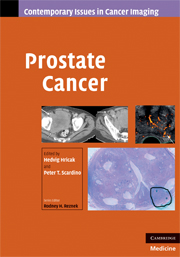Book contents
- Frontmatter
- Contents
- Contributors
- Series Foreword
- Preface
- 1 Anatomy of the prostate gland and surgical pathology of prostate cancer
- 2 The natural and treated history of prostate cancer
- 3 Current clinical issues in prostate cancer that can be addressed by imaging
- 4 Surgical treatment of prostate cancer
- 5 Radiation therapy
- 6 Systemic therapy
- 7 Transrectal ultrasound imaging of the prostate
- 8 Computed tomography imaging in patients with prostate cancer
- 9 Magnetic resonance imaging of prostate cancer
- 10 Magnetic resonance spectroscopic imaging and other emerging magnetic resonance techniques in prostate cancer
- 11 Nuclear medicine: diagnostic evaluation of metastatic disease
- 12 Imaging recurrent prostate cancer
- Index
- Plate section
- References
6 - Systemic therapy
Published online by Cambridge University Press: 23 December 2009
- Frontmatter
- Contents
- Contributors
- Series Foreword
- Preface
- 1 Anatomy of the prostate gland and surgical pathology of prostate cancer
- 2 The natural and treated history of prostate cancer
- 3 Current clinical issues in prostate cancer that can be addressed by imaging
- 4 Surgical treatment of prostate cancer
- 5 Radiation therapy
- 6 Systemic therapy
- 7 Transrectal ultrasound imaging of the prostate
- 8 Computed tomography imaging in patients with prostate cancer
- 9 Magnetic resonance imaging of prostate cancer
- 10 Magnetic resonance spectroscopic imaging and other emerging magnetic resonance techniques in prostate cancer
- 11 Nuclear medicine: diagnostic evaluation of metastatic disease
- 12 Imaging recurrent prostate cancer
- Index
- Plate section
- References
Summary
Introduction
In 2005, approximately 128 000 American men were newly diagnosed with recurrent or advanced prostate cancer. For the vast majority of these men, hormonal therapy is the most common first line of treatment [1, 2]. This first-line hormonal treatment is typically surgical or medical castration, which is known as androgen-deprivation therapy. Most patients show a response to androgen-deprivation therapy as manifested by a drop in prostate-specific antigen and/or symptomatic improvement. Ultimately, all patients on androgen-lowering therapy eventually fail this treatment, with the re-emergence of castration-resistant tumors. These tumors may still be susceptible to secondary hormonal therapies that block androgen receptors, decrease the adrenal production of androgens, or increase circulating estrogens. Like androgen-deprivation therapy, secondary hormonal therapies improve symptoms and induce variable decreases in prostate-specific antigen, but they also have not been shown to provide a survival advantage. These patients will ultimately progress despite an initial success with such hormonal maneuvers.
Clinical states model of prostate cancer
The clinical states model of prostate cancer developed at Memorial Sloan-Kettering Cancer Center defines milestones for assessing prognosis and defining therapeutic objectives and outcomes in patients with advanced prostate cancer (Figure 6.1) [3].
- Type
- Chapter
- Information
- Prostate Cancer , pp. 93 - 101Publisher: Cambridge University PressPrint publication year: 2008



